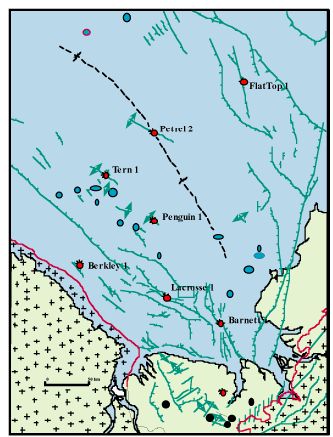 |
 |
 |
 |
 |
 |
||
 |
|||||||
SOUTHERN BONAPARTE BASIN
REGIONAL SYNTHESIS OF THERMAL HISTORY RESULTS IN BERKLEY-1, LACROSSE-1, PENGUIN-1, TERN-1, KEEP RIVER-1, BARNETT-1, PETREL-2, FLAT TOP-1 AND ONSHORE SHALLOW CORES USING APATITE FISSION TRACK ANALYSIS AND VITRINITE REFLECTANCE
A non-exclusive study by Geotrack International
New thermal history data have been obtained from a total of 46 AFTA samples and 59 VR samples in 8 wells and 8 outcrop locations in the southern Bonaparte Basin. The study also incorporates open file VR data in a further 153 samples.
In this study, THR™ (Thermal History Reconstruction) has revealed key aspects of the evolution of this region, including quantitative estimates of the timing and magnitude of maximum paleotemperatures, paleo-geothermal gradients in the Late Cretaceous-Tertiary and Jurassic, and amounts of uplift and erosion. Our thermal history approach has also enabled constrained predictions of the maturation levels of key source rock units.
These issues are vital to a rigorous evaluation of the hydrocarbon potential of the southern Bonaparte Basin, and have been addressed by direct and quantitative assessment of thermal histories using new AFTA and VR results.
Introduction and objectives:
This report describes the results of a non-exclusive study in which Apatite Fission Track Analysis (AFTA®) and Vitrinite Reflectance (VR) are used to identify, characterise and quantify the major episodes of heating and cooling which have affected the southern Bonaparte Basin, including onshore regions. New information is used to reconstruct a thermal history framework from which the burial and uplift, and hydrocarbon generation history can be understood. This report complements and extends a previous non-exclusive study of the Bonaparte Basin (Geotrack Report #337) carried out by Geotrack International in 1992.

Objectives of this regional synthesis were:
1) To determine the timing and magnitude of maximum paleotemperatures in each sample;
2) To determine the timing and magnitude of any additional paleo-thermal events;
3) To determine the profile of maximum paleotemperatures in each well;
4) To characterise the mechanisms controlling heating and cooling in each episode;
5) To estimate, where appropriate, the amount of section removed by uplift and erosion;
6) To assess the regional variation in mechanisms of heating and cooling, styles of thermal and burial histories, and potential for hydrocarbon generation.
Detailed results for each of the study wells are available in the Report, as are discussions on the variations in the styles of the thermal, burial and maturity histories throughout the region.
• Comprehensive Report available from April 1998
• Two volumes - containing over 400 pages including colour figures, tables and data appendices
For further information, please contact us